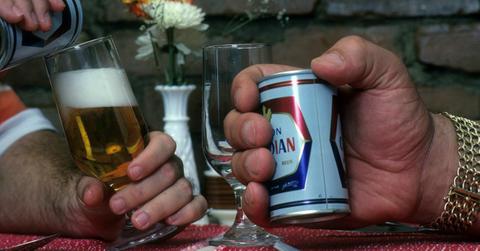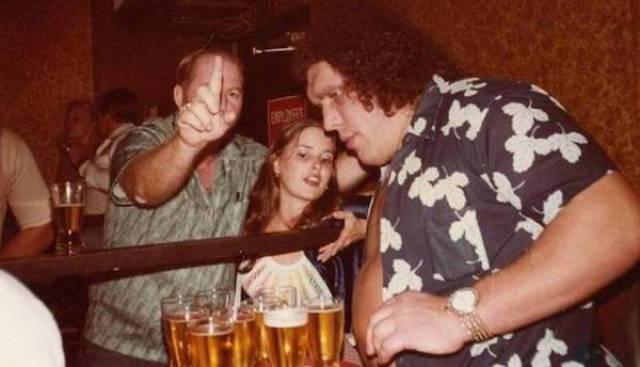10 Incredible Facts About André The Giant That Prove He Was Larger Than Life
Updated Dec. 21 2018, 11:04 a.m. ET
It's easy to fall into the trap of wanting to be another person. To live another life or pretend to have the feelings and mannerisms of another individual. Because oftentimes we feel like we're not enough.
We're not beautiful enough or smart enough or jacked enough. If only our jawline was more pronounced or if your parents loved you more or they had more money things would've turned out differently.
But then there are individuals who find a way to love themselves. I'm talking about someone who does the most with who they are. What they were born with and born into. And they take that, weaknesses and all, and go to the moon with it.
André the Giant was one of those people.
Tons of kids like me grew up watching professional wrestling. Seeing these amped-up, musclebound, hyper-men in leotards pour their feelings out inside of a ring meant everything. They would talk the talk and then walk the walk. I saw a bunch of dudes fighting for their lives and it was glorious.
Some characters stood out more than others, like André the Giant. It's not just the fact that guy was humongous. There are other pro wrestlers out there who are insanely big and as tall, or even taller, than André, like Silo Sam, Giant Gonzalez, and Paul Bunyan, but few people remember those names as much as they remember his. And now, HBO's new documentary about the man, directed by Jason Hehir, shows why this is the case: André lived a tremendous life despite being plagued by hardship.
André wasn't always so giant.
Roussimoff (Andre the Giant's non-pro-wrestling last name) didn't start growing at an alarming rate until he hit the age of 15, before that, "he was normal" says his mother, Antoine, in the documentary. His family soon worried that he would never stop growing as he got larger and larger over time.
André could've treated his acromegaly, but didn't want his appearance to change.
Dr. Harris Yett in the documentary says that he treated a broken ankle injury sustained by André and that his ankle bone was about the same size as a normal person's knee. Although Rousimoff could've received treatment that would mitigate the effects of acromegaly, and thus the pain he endured as a result of it, André refused, believing it would destroy the career he earned based on his physical appearance.
He was pro-wrestling's first real national breakout star.
While certain pro wrestlers dominated local popularity circuits, André the Giant was the first to be a draw in different circuits across the board. He would move from region to region all across America after immigrating from Europe, often selling out each card he'd perform in.
His career was threatened early on.
Because André was hitting the pro-wrestling circuits hard, fans would see the giant perform and then lose interest - they saw the huge man and then didn't feel compelled to see him again. Thanks to the career management of Vince McMahon Sr., who took a "less is more" approach to André's performances, getting him to briefly wrestle here and there, more buzz circulated his name. As a result, Andre's notoriety grew and so did national interest in the performer as well.
Rousimoff used local news appearances to sell himself.
Hulk Hogan praises André as being the first wrestler to truly understand how to "monetize" himself, and Rousimoff confirms this in Hehir's documentary when he says he used "what God gave me to make a living". He'd have bits with local journalists where he'd lift massive amounts of weight, shake journalist's hands with his own massive mitts, have them try on his clothing, or perching them on his shoulder, Rousimoff knew how to give the people what they wanted.
The man's farts were serious.
"When he passed gas, it was an event," Vince McMahon chuckles in the documentary. André the Giant, apparently, had massively loud, long, and stinky farts. In fact, they were so bad that fellow wrestlers hated traveling with him, and Hogan once recalled an incident where he was flying in an airplane with André, who ripped one so putrid, the pilots began freaking out.
He didn't like other people taking his spotlight.
A fellow big wrestler, Big John Studd once copied André the Giant's signature ring entrance move of stepping over the top rope. André didn't like that, scaring Studd so much that Big John once exited the arena in a hurry, legitimately afraid that André was "going to kill [him]." He's also beefed with Macho Man Randy Savage because he hated, absolutely hated, baby oil and Macho Man would slather himself in the stuff.
One of the most iconic moments in WWF history was done on André's whim, mid match.
There was a lot of back-and-forth between André the Giant, Hulk Hogan, and Vince McMahon whether or not the hulking Frenchman would step into the ring for the iconic 1987 match at Wrestlemania III. Even while Hogan was writing the script for the bout the night before in a Detroit hotel room, Rousimoff's worsening acromegaly condition made his participation in the match doubtful.
André showed up, all poise, while Hogan recounts being nervous as all hell during the match. He worried, even while they were wrestling in front of a sold-out crowd of almost 100,000 fans, that André wouldn't follow the script for the match that had him losing to to the Hulkamaniac. Once Hogan realized that André was willing to lose and give the fans an amazing moment: where the giant was body-slammed by America's new wrestling icon, he recalls feeling immense relief. André was capable of being bigger than the show itself, but chose not to be that night.
André the Giant consumed inhuman amounts of booze on a daily basis.
André would drink massive quantities of alcohol, which was due in part to the pain he endured due to his acromegaly - a constant buzz kept the pain at bay. Ric Flair says that he was with Rousimoff the night he drank 106 beers in a single sitting. Jerry "The King" Lawler claims the Giant never had fewer than 24 beers when they would go out drinking.
Gene Okerlund says that André would start the day with a case of wine...not a bottle. A case.
He was indeed a "gentle giant" and was sensitive to people's jokes at his expense.
Due to his size and the nature of his work, Rousimoff was constantly traveling in physically uncomfortable situations. He'd need entire plane rows to accommodate his size. Squeezing in and out of cars was difficult, airplane bathrooms were a no-no and he'd need a curtain drawn to pee in a bucket. In public, when people would make remarks about his size or call him names, he would cry. In Hehir's documentary, a clip of André the daily struggles with his size ends up being one of the most profound moments of the film.
"It’s difficult everywhere I go. They don't have anything for big people. They've got everything for blind people, for crippled people, for some other people but not for big people. So, we have to fit in there and it’s not too easy all the time."
Even though his epic match with Hogan was before my time, I would watch reruns of Rousimoff's matches, had his action figure, and would constantly play as him in the Wrestlemania game for NES. He was a beloved figure of my childhood and a pro-wrestler who stood above others, despite not really having a gimmick.
Sure he was huge, but he was more than just an enormous man. He lived an enormous life and you never felt that he was taking any of it for granted. Hehir's documentary highlights that, and, as hackneyed as it sounds, we could all learn something from André. There's a reason why he's so inspiring, it's because there's a weakness in all of us that's just waiting to be exploited in the right direction so we can live our best lives.


